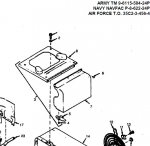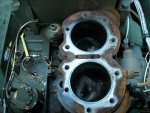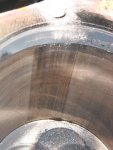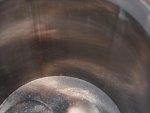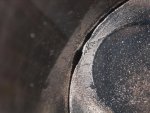Finally tested!!!! NOW What?
So, thanks to Stan (NJ_ToolNut) I was able to attempt a pressure test of the compression on a cold MEP002A.
It has been a long time coming, due to my being a slacker. Stan made a wonderful tool, and quickly too. I just was not gettin' er done.
I bought a Compression Tester from NAPA (PN SER 2428 ) becuase it had a 1/4" NPT end on the hose. It only goes to 300psi on the guage but has a pretty good area after that before it hits the pin again. I'm thinking close to 400 psi before the needle is against the pin.
With some simple pipe thread adapters, I was able to get the whole thing together. Cylinder one was real easy. Just take out the glow plug with a 1/2" deep-well socket. Put the adapter in. Cylinder two needed to have the manifold removed to get at the glow plug easily
So it wouldn't try to run, I disconnected the wire plug connector just above the IP. That keeps the fuel selonoid from energizing. Now, just crank it over until the needle stops moving up. Right?
Well! The manual says compression ratio is 19:1. I just figured the pressure would be about 270 psi (a bit less than 19*14.7) WRONG!
Cylinder One was OVER 400 psi in a couple of revolutions. Buried the gauge needle hard against the pin. Cylinder two then only goes up to about 175psi. BUT I probably fubared the gauge when it hit the pin on cylinder one. Back onto cylinder one. Yep, still will go over 300. (Stopped cranking before it hit the pin).
SO, off to do more research. I now have a means to test the compression pressure. What should it REALLY be though?
7-8.1. ENGINE COMPRESSION TEST.
The engine cylinder compression tests of this
paragraph may be used to determine the condition of
engine valves, pistons, piston rings, and cylinders.
Normal cylinder pressure should be between 350 to 450
psi, depending upon engine condition. Corrective
maintenance should be considered if cylinder pressure
is below 325 psi or if there is a pressure difference of
15% or more between cylinders. These pressure ratings
apply to a warm engine at cranking speed (approximately
300 rpm).
The rest of this post is just engineering ranting.
Wikipedia to the rescue.
Diesel Engine Compression Ratios states a compression ratio between 18:1 and 23:1 for indirect injection engines. That agrees with the military manual statement of 19:1. A few more lines down, I see an equation for the pressure. It uses "specific heat ratio".

Now my thermodynamics teaching is coming back to me. In simplistic terms, compression in an engine is an
adiabatic process. Pressure * Volume^(gamma) = Constant. (gamma is the specific heat ratio of the air ~1.4).
Compression ratio = Volume at BDC divided by Volume at TDC. Some simple math and I got the equation for the pressure in the wikipedia article. Wikipedia also has
Compression_ratio_versus_overall_pressure_ratio table.
So now I think the pressure should be around 900 psi. Obviously more than the gauge I have now. But I am still guessing at what the correct pressure is.
--Update-- Since now I know the pressure, it just goes to show that in theory there is no difference between theory and reality. In reality....




 Now my thermodynamics teaching is coming back to me. In simplistic terms, compression in an engine is an
Now my thermodynamics teaching is coming back to me. In simplistic terms, compression in an engine is an 
